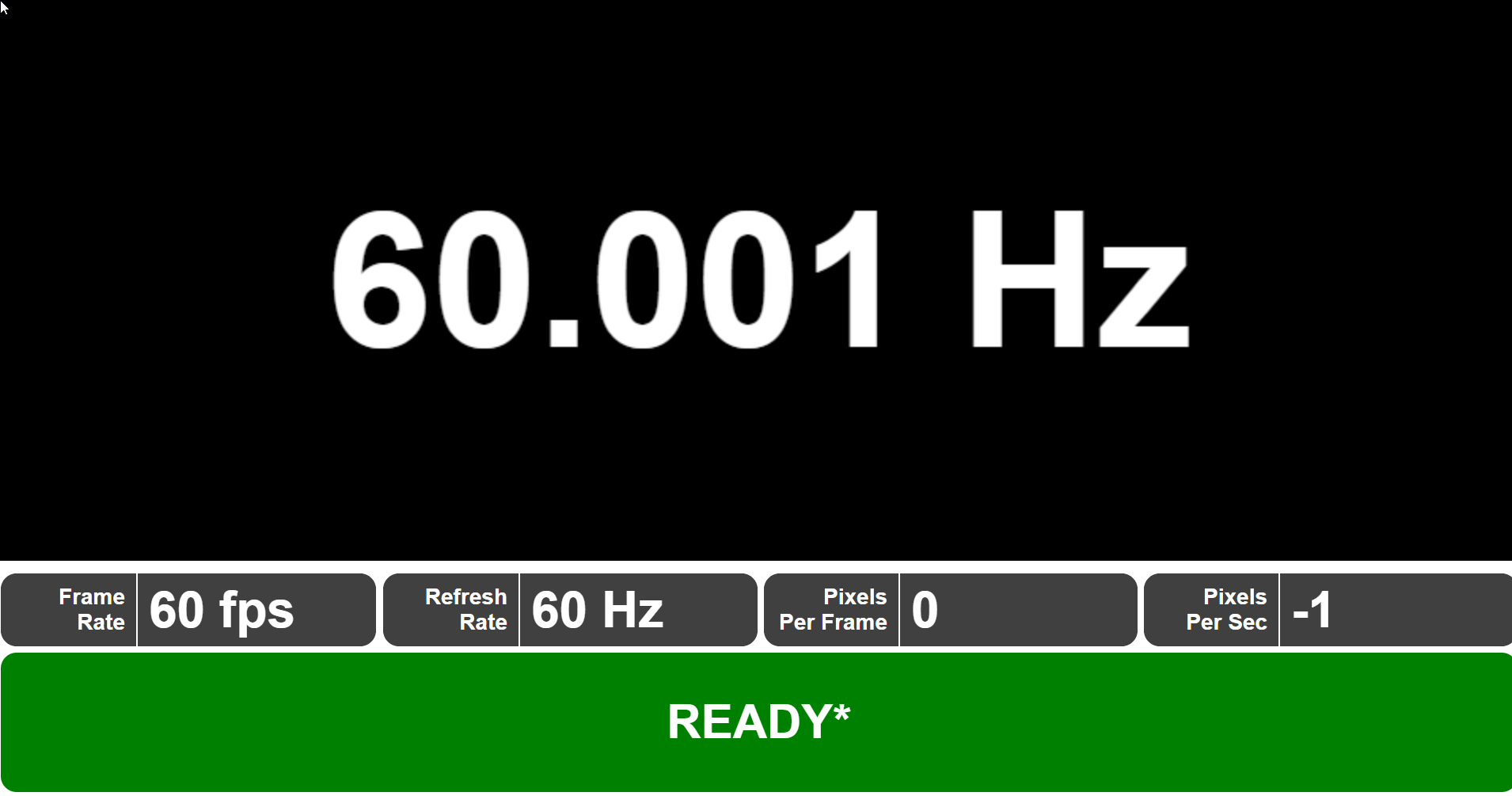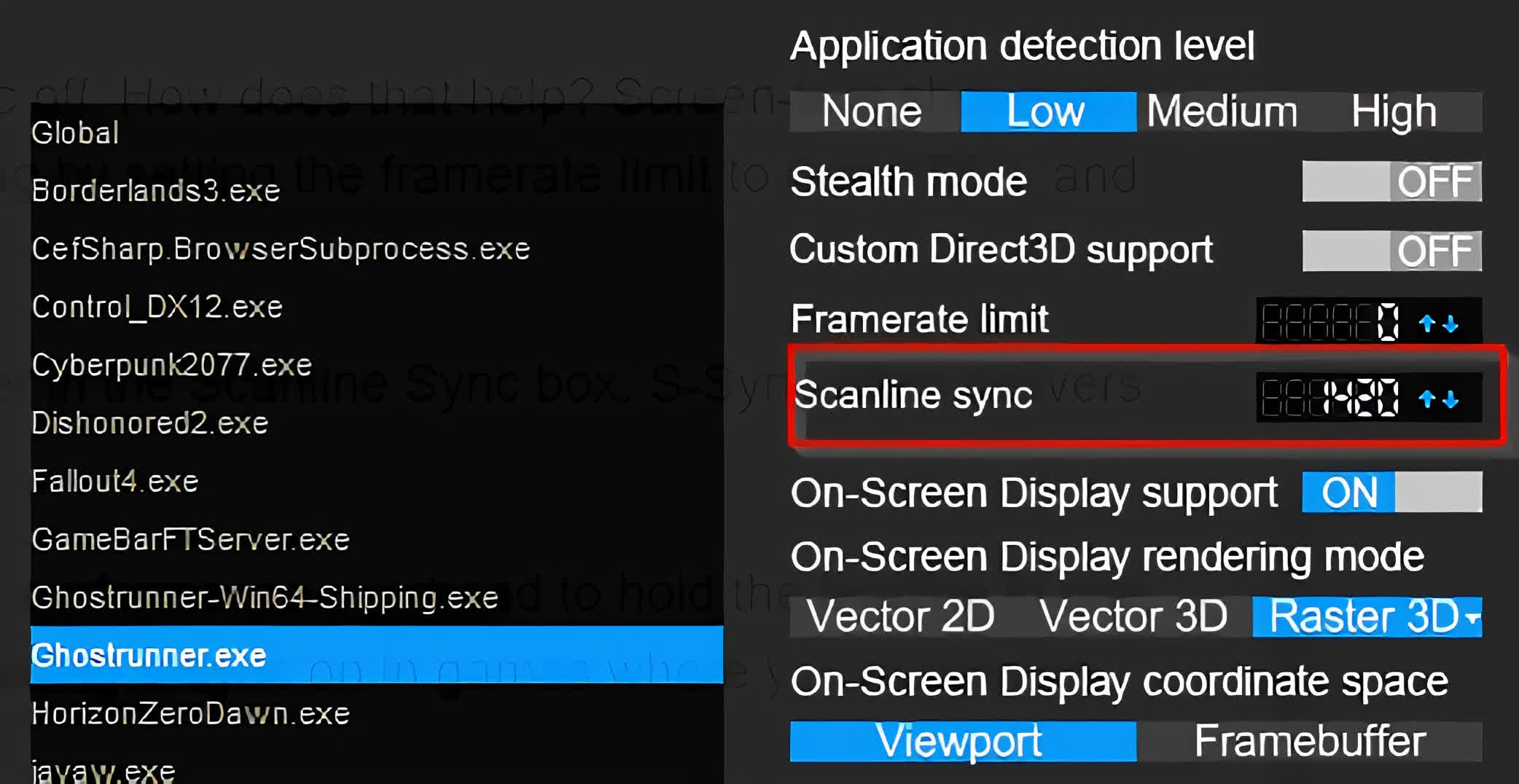Screen tear or Watch The Fourth Body Onlineinput lag? To vsync or not to vsync? For the longest time, this was an either-or question in the PC gaming space. You could either have a tear-free, properly frame-paced image or low input latency. You couldn't have both. Or could you?
Well that depends. If you already have a modern gaming monitor that supports variable refresh rate (FreeSync or G-Sync), you don't need to use this guide at all. Butif you have a regular, fixed refresh rate monitor, or if you like to play games on your TV, this guide will help you get a tangibly better experience in terms of screen tearing and input lag.
By leveraging millisecond-accurate frame-capping in RTSS (Rivatuner Statistics Server), you can enable low-lag vsync on. The result? Clear, tear-free image quality and input latency that's up to 50 ms lower than conventional vsync.
This is one of those rare PC tweaks that can massively improve your gaming experience with minimal tradeoffs and no investment. What the heck is it? And how do you do it? We'll walk you through, step by step, in this guide.

Before getting into the how-to, it's a good idea to understand exactly what we're doing. Low-lag vsync on is a technique that helps to reduce your input latency. What does that actually mean? When you type on your keyboard or move your mouse, there's a slight, almost imperceptible lag between the action you take and the output on your display. This lag is so minor that it's measured in milliseconds. When you're using your computer to browse or playing casual games, it doesn't tangibly affect the experience.
Also read: How Many FPS Do You Need? Frames Per Second, Explained
However, in competitive situations like esports shooters, every millisecond counts. A few ms of input lag could mean the difference between getting that headshot or getting scoped yourself.
All monitors (and TVs) add a certain amount of input lag by default. This is typically dependent on the type of panel being used. High-refresh rate IPS and TN panels deliver the lowest input latency out of the box. Some monitors go as low as 0.5 ms. VA panels tend to have more input lag, with many panels in the 8-10 ms. TVs (which often use VA panels) tend to be the worst performers, with some that go as high as 30 ms or more.
When vsync is turned off, your GPU sends rendered frames to the display as fast as it can. Because the display can only output frames so fast (1 frame every 16.66 ms for 60 Hz panels), screen tearing happens when a new frame arrives before the previous frame's out of the picture.
When conventional vsync is enabled, the GPU is no longer able to replace the contents of the monitor buffer with a new frame, before the old frame gets its 16.66 ms of fame. This means every frame gets to be displayed in its entirety, eliminating screen tearing. However, this forces the GPU to queue up frames, instead of sending them as fast as possible.
Because of queuing, conventional vsync can add as much as 50ms of latency on top of your display's baseline input lag. This is where low-lag vsync comes into the picture.
With the low-lag vsync technique, you're essentially capping the framerate (how fast the GPU outputs frames) to a number that's every so slightly below the monitor's refresh rate. This prevents the GPU from sending new frames in before the monitor's ready to output them. The result? A screen-tear free experience with latency that's almost as good as vsync off. Here's how you can do that...
Before getting started, you will need to download the latest version of Rivatuner Statistics Server (RTSS). You will also need an active internet connection, so that you can access these two web pages for running tests:
The HPET (High Precision Event Timer) should be enabled in your BIOS. If you've disabled it for some reason, please go back in and enable it.
The first thing you want to do is determine your monitor's actual refresh rate. If you have a 60 Hz panel, it will likely be very close to 60, but off by a few hundredths of a second. Use either the UFO Refresh Rate Test or vsync Tester. If you have extra time on hand, use both to see if the numbers align.
To test your monitor's refresh rate, close out all other tabs in your browser and any background processes, then wait for 30 seconds to 1 minute. The test page will show your display's refresh rate down to several decimal places. Round it to three digits for the next step.

Once you have Rivatuner installed, make sure to run it with administrative privileges. Then, click on the green "Add" button at the bottom left. Browse to the install location for your game. (Note, you can set this globally, too, we prefer customizing on a per-game basis).
Select the game executable, then add it to Rivatuner.

Take your three decimal-place refresh rate, then subtract 0.01 from it. If your refresh rate is 60.001, for instance, your frame cap will be 59.991.
In the Rivatuner interface, select the game on the left hand side. Then, type in your frame rate cap in the box next to frame rate limit. You've now limited your game's frame rate to just under the monitor's refresh rate. You'll want to play around with this number a little bit. Some games are more sensitive to frame capping than others: if you experience lots of judder, trying adding to the frame rate cap by increments of 0.002.
Launch your game, then make sure to enable vsync in settings. If you're unable to do this, force driver-level vsync from the AMD or Nvidia Control Panel, and that's it!
With low-lag vsync enabled, you'll enjoy substantially better input latency without screen tearing. There are a few caveats you'll need to pay attention to. Low-lag vsync works best if your system is capable of running consistently above the monitor's refresh rate. If you're just hitting the 60 FPS mark, enabling this could cause additional stutter, whenever frame rates dip below.
If you don't want to play around with fractional frame rate capping, RTSS offers an alternative: scanline sync. Scanline sync allows you to control where screen-tearing takes place on screen, with vsync off.
How does that help? Screen-tear shows up as a single line that you can then tuck it into the monitor's overscan - at the very top or bottom of the screen, where it effectively disappears. To enable scanline sync, make sure to disable framerate capping by setting the framerate limit to 0 in RTSS, and disable in-game or driver-level vsync.

Then, decide where you want the scanline to be. You'll want to experiment with this, but ideally, take your monitor's vertical resolution (1440 if it's a 1440p monitor), then subtract 10 to 20. Set this number in the Scanline Sync box. S-Sync often delivers even lower input latency than low-latency vsync.
However, note that you will need a powerful system (or a less intensive game) to make the best use of it. In games where your GPU utilization consistently goes above 80 percent, S-Sync doesn't have the performance overhead to hold the tear line in one place and it can cause massive stuttering.
As a rule of thumb, use S-Sync for less intensive games, where your average frame rate can go significantly above 60 FPS. Use low-lag vsync on in games where you're running closer to 60 FPS.
Certain PC performance tweaks can have a placebo effect or have tradeoffs, as is the case with resolution scaling. But with low-lag vsync, you really are getting a better experience with no tradeoff. If you have the performance headroom to spare but you're not using a gaming monitor with VRR, low-lag vsync on can transform the feel of twitch shooters and competitive games, while getting rid of screen tearing.
There's no special equipment involved and the only software you need is RTSS. If you've followed this guide, you should see a significant improvement in input latency and responsiveness across your game library.
 Exceptionally rare radio sources detected in the distant universe
Exceptionally rare radio sources detected in the distant universe
 Teacher warns students not to spoil 'Avengers: Endgame' with fantastic note
Teacher warns students not to spoil 'Avengers: Endgame' with fantastic note
 Amazon Music Prime is adding 98 million songs, but only on shuffle
Amazon Music Prime is adding 98 million songs, but only on shuffle
 Apple's M2 MacBook Pro and Mac mini reportedly delayed until 2023
Apple's M2 MacBook Pro and Mac mini reportedly delayed until 2023
 Best headphones deal: Save up to 51% on Beats at Amazon
Best headphones deal: Save up to 51% on Beats at Amazon
 'Snitty' is Twitter's word of the day after Bill Barr's Senate testimony
'Snitty' is Twitter's word of the day after Bill Barr's Senate testimony
 'Quordle' today: See each 'Quordle' answer and hints for October 30
'Quordle' today: See each 'Quordle' answer and hints for October 30
 Crypto exchange Deribit loses $28 million in a hack
Crypto exchange Deribit loses $28 million in a hack
 Best portable power station deal: Save $179.01 on the EcoFlow River 2 Max
Best portable power station deal: Save $179.01 on the EcoFlow River 2 Max
 Tech employees laid
Tech employees laid
 'Mario Kart World' Nintendo Direct: 3 takeaways
'Mario Kart World' Nintendo Direct: 3 takeaways
 Wordle today: Here's the answer, hints for November 2
Wordle today: Here's the answer, hints for November 2
 The cursed 'vegan lasagna' is simply not a lasagna
The cursed 'vegan lasagna' is simply not a lasagna
 It turns out purposely messing with your targeted ads isn't a good idea
It turns out purposely messing with your targeted ads isn't a good idea
 Shop the Shark FlexStyle for 20% off at Amazon
Shop the Shark FlexStyle for 20% off at Amazon
 'Bring Your Kids to Work Day' didn't go so well for Sarah Huckabee Sanders
'Bring Your Kids to Work Day' didn't go so well for Sarah Huckabee Sanders
 Tech employees laid
Tech employees laid
 YouTube announces Primetime Channels streaming hub
YouTube announces Primetime Channels streaming hub
 Apple is actively looking at AI search for Safari
Apple is actively looking at AI search for Safari
 'The White Lotus' Season 2 review: Go on vacation with the horny elite
'The White Lotus' Season 2 review: Go on vacation with the horny elite
New tweak to Japanese law wipes out thousands of Airbnb listingsGive this dog a Dundie for recreating the entire opening intro of 'The Office'Mom has lunch in same restaurant as Andrew Garfield, boldly asks him to record video for her sonMom has lunch in same restaurant as Andrew Garfield, boldly asks him to record video for her sonHBO Max is expanding further in Europe'Dying Light 2' review: A stellar sequel bookended by a slow start and a weak finishDennis Rodman cries over TrumpGoogle pays tribute to suffragist with stunning DoodleWordle is downloadable, so it will always stay freeTesla has issued a recall of 817,000 vehicles over a seat belt chime problemCruise driverless taxi service launches in SFAngela Merkel's photo of Donald Trump at G7 drew a big responseMindy Kaling burns Trump twice in powerful commencement speechDennis Rodman cries over TrumpTesla has issued a recall of 817,000 vehicles over a seat belt chime problemYouTuber asks the internet *not* to Photoshop his pleasant honeymoon photoRoland Emmerich's 'Moonfall' crashes and burnsTaylor Swift news: 'Taylordle' is the 'Wordle' clone for SwiftiesPornhub: Users love searching for yoga pants and sneakersHBO Max is expanding further in Europe The surprising list of top Netflix shows in the US by state Nest put a microphone in its security hub without informing customers 'Anthem' review: BioWare's dance with 'Destiny' has a rough start Netflix's 'Friends From College' won't be back for a third season Apple plans to merge iOS and macOS apps by 2021, report says 5 most savage quotes from damning report on the 'digital gangsters' at Facebook LG says it's 'too early' for foldable phones YouTube changes 'strike' policy for first America's favorite undecided voter Ken Bone is now a brand influencer The 1975 used their BRIT Awards speech to call out misogyny in the music industry Lyft reportedly will beat Uber to IPO The best places to go on the internet if you stan possums 7 takeaways from Mark Zuckerberg's Harvard discussion about Facebook When Michelle Obama goes high, she takes every woman with her Restoration YouTube will bring you deep into an internet rabbit hole Twitter opens beta program to test new conversation features YouTube is 'actively enabling' the spread of exploitative content, report finds Huawei founder speaks amid pressure: 'The U.S. can't crush us' U.S. won’t have emoji on license plates any time soon Millennial spending habits are being questioned (again) and the internet isn't here for it
2.8376s , 10156.3671875 kb
Copyright © 2025 Powered by 【Watch The Fourth Body Online】,Pursuit Information Network